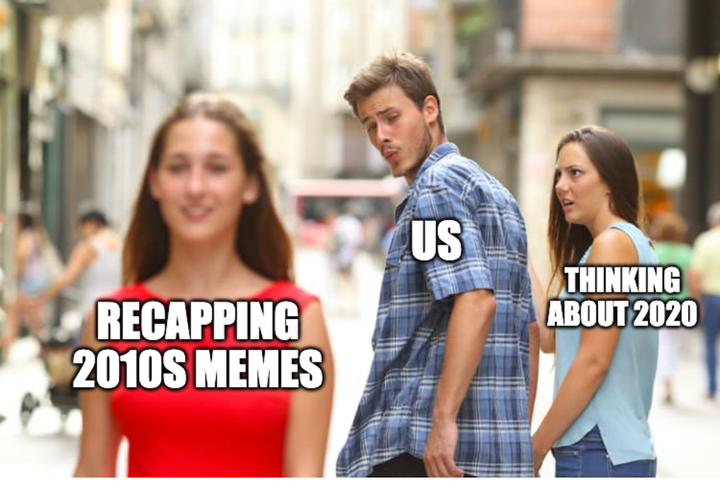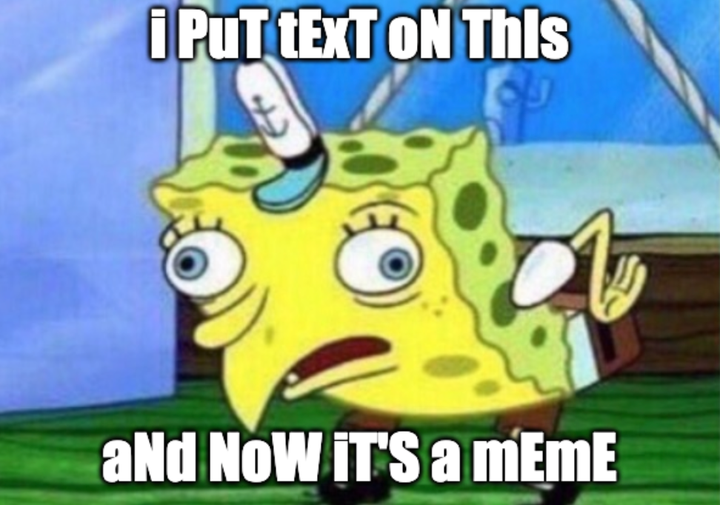
What is in a meme?
It’s a question worth considering as we close the book on the 2010s and head bravely into 2020. If the 2000s gave us the concept of memes and social media, 2010 took that concept and rolled with it, letting memes become an even more important part of our lives.
Looking back on the past 10 years, society has changed a lot. We started the decade with Barack Obama as United States president, Stephen Harper as Canadian prime minister and “Glee” as one of the number one shows on TV.
We end it with U.S. president Donald Trump impeached, Canadian Prime Minister Justin Trudeau guiding a minority government into an uncertain future and the “Glee 3D Concert Experience” is a distant memory.
It’s safe to say, things are different. And according to experts, our memes and the way we use social media reflects that, too.
Think of your favourite memes from the past decade. Remember Old Spice Guy? What about Balloon Boy? And who can forget doge, “what’s better than this, guys being dudes” or sad Keanu?
From Rage Comics to Smudge The Cat, our memes have changed as much as the world around us. But first we have to start at the beginning — and I’m not talking about 2010.
What are memes?
You might think memes are a unique product of the internet age. But actually, the term was coined in 1976 by Richard Dawkins as a way to broadly refer to ways of spreading ideas and cultural phenomena.
Of course, Richard Dawkins probably didn’t see Baby Yoda’s enormous, soul-encapsulating eyes coming. No one did.
And that’s the cool thing about memes, Ryerson University professor Richard Lachman says. You can’t predict whether they’ll zig or zag.
“The only thing we can say is we will be totally surprised when it happens and when it does happen it will seem effortless,” he told HuffPost.
Memes as we think about them now can be images, sounds, words, phrases, videos or basically anything else that is shared around. A Twitter user saying a cat can have “little salami as a treat” is just as much a meme as a “rage comic” or a video of the Old Spice Guy. Often, memes are even reinterpretations or evolutions of previous memes that came before.
Since the start of the decade, Lachman says, platforms have shifted dramatically. The late-aughts and early 2010s were ruled by slick, highly produced videos on YouTube content creators as well as challenge-based memes that encouraged everyone to get involved.
The start of the 2010s was dominated by mass participation. Challenges of all kinds raged rampant, encouraging people to become a part of something by doing everything from a specific dance to snorting cinnamon.
My first job was working as a hostess at a chain restaurant in Red Deer, Alta. And within a few months of my working there we filmed a “Harlem Shake” video, complete with wacky costumes, that memorable music drop and even the also timely “screaming goats” meme.
It was the thing to do, because everyone else was doing it. University of Winnipeg professor Matthew Flisfeder says that’s what memes are about — they inspire a feeling of being part of something.
“I think that one of the ways that different subcultures or political movements or social movements are able to grow a mass amount of attention, or solidarity, if you want to call it that is through through art and culture,” he said. “And I think memes are a very good example of one of the dominant forms of art and culture.”
“When I’m sharing content, I’m copying me,” he said. “In part I’m trying to do something that maybe gives this little nod and a wink to the people who are like me, so it’s a way of kind of noting my connection to an in-group.”
WATCH: How to do the Harlem Shake. Story continues below.
Some challenges were motivated by a cause — for instance, the “ice bucket challenge,” which involved people dumping buckets of ice on themselves — was intended to raise money and awareness for ALS. Others, like the “cinnamon challenge,” where people ingested pure cinnamon, were mostly targeted at achieving virality.
But they all involved being part of something and contributing to the discourse. Other popular memes throughout the decade do the same thing by creating and maintaining subcultures — it’s funny if you “get” it.
If you know the original meme — say, “double rainbow” , a 2012 viral video of just that — then you’ll recognize and identify with a video of Kermit the Frog singing a song inspired by it.
Lachman says memes go viral because people take a piece of content and continuously inject little bits of themselves into it. He points to simple examples of image memes with text over them.
“I can take the same background image and change the text on it,” he said. “You recognize what I’m saying. But I’m able to save my own my own voice or my own little joke, a little bit of self interest.”

RIP Vine
If there was a platform to define the memes of the middle of the decade and that sense of having to be in on the joke, it was Vine, a short-form video looping service launched in 2013 and essentially shuttered in 2017. Users could record short videos — usually no more than six seconds — and share them with various effects. Many of the decade’s greatest memes were born from the platform.
Take “Who is She” for example, a six-second video filmed by Chloe Woodard in 2015 featuring her dancing to A-Ha’s “Take On Me.” The original viewed more than 60 million times in the three months after it was posted and inspired numerous parodies, including one featuring Jeff Goldblum that was viewed over 30 million times.
“Vine had a more amateur nature to it,” Lachman said. “Because they were so short there were a lot of teens who could gravitate to being successful people on Vine.”
In a 2016 interview with the Verge, Vine co-founder Dom Hoffman said that when they conceived the platform, they had no idea how big it would be in creating memes.
“It became pretty clear as soon after we launched,” Hofmann said. “Watching the community and the tool push on each other was exciting and unreal, and almost immediately it became clear that Vine’s culture was going to shift towards creativity and experimentation.”
Vine faded out of existence in 2016 after parent company Twitter opted to put its resources elsewhere, but many of the platform’s videos are still online and can be viewed in a browser. The app they were born from is gone.
TikTok on the clock, but the party don’t stop
But the spirit of Vine lives on, Lachman says, in TikTok.
“We’re seeing those same recreations. And it really seems to be part of the ethos of TikTok, that amateur nature,” he said. “It’s supposed to be self-mockery. And that’s welcoming and encouraging.”
Flisfeder agrees.
“When you look at TikTok, the way in which TikTok reproduces itself is very similar to the way that meme is reproduced themselves,” he said.
For the uninitiated, TikTok is a mobile app that allows users to create short music and lip-sync videos of three to 15 seconds and short looping videos of three to 60 seconds. Users often repurpose audio from movies, songs and other TikToks to create a new version and contribute to the meme.
Flisfeder give the example of the Heathers meme on TikTok, which is set to audio from the Broadway musical “Heathers.” Versions have been performed by people young and old all around the world.
“Other users try to replicate and reproduce the same performance. And it adds a humorous dimension to it,” Flisfeder said.
TikTok and its Chinese counterpart Douyin have taken over the meme-o-sphere in the past year or so. And much like with Vine, celebrities and companies are getting in on the action too. The TikTok account for the Washington Post has garnered a huge following, and NDP leader Jagmeet Singh used the platform to much delight during this year’s federal election campaign.
But Tiktok doesn’t just represent a format change that’s occurred over the past decade. It also highlights a political one. Lachman says in 2010, social media platforms were largely localized to regions — China had popular platforms in China, while Russia had popular platforms in Russia.
But in the back half of the decade, those geopolitical lines have blurred through memes.
“In the early parts of the decade, we were divided in terms of a global population,” Lachman said. “In terms of who’s posting, people were mostly talking to themselves nationally and by language.”
But TikTok, Lachman argues, has “broken that.” He said the app’s origins from merging various companies targeted at different parts of the world, and the fact that its largely dependent on music and recycled content rather than direct language communication, make it perfect space for global memes.
“Now in the same stream of your TikTok you’re getting people from around the world, you’re getting content from India, you’re getting content from mainland China and midwestern America and the middle of Canada,” he said.
The app certainly is surging. It’s is available in 145 countries around the world and boasts 1.5 billion cumulative downloads. And 43 per cent of new users are in India.
What next?
Flisfeder says the future of memes and social media use will come down to how heavily our internet is regulated. Over the course of the 2010s, platforms like Twitter and Facebook were allowed to go untethered. But in the later years of the decade, we saw figures like Facebook CEO Mark Zuckerberg face accountability for their platforms and what could be shared.
“We have a wonderful democratic resource that is being transformed because of the business interest of platforms,” he said. “This is a problem of neoliberal capitalism.”
He says how that moves forward will depend a lot on the political bent of governments. Lachman agrees, and notes that the free wheeling global nature of TikTok is built on a very political foundation.
“TikTok is produced by China and there are different regulations around where that data might be stored and how the AI algorithms are going and tracking and using that data,” Lachman said.
And that trickles down to our memes too.
While many memes from the past 10 years seem detached from politics — think of doge, doge never did anything wrong. Many are deeply tied to it.
Flisfeder points to the alt-right’s use of memes, something we see pushing forward movements like western separatism in Alberta
WATCH: Infowars sued by creator of Pepe the Frog. Story continues below.
He says if those political movements continue to grow, so will associated memes, pointing to the rise of U.S. president Donald Trump and his use of Twitter to connect to voters.
But both Lachman and Flisfeder agree our meme future is impossible to predict.
“It’s like trying to predict five or 10 years of fashion trends,” Lachman said. “As much as we can predict where technology is going, I don’t think something we can predict is the social behaviours.”
CORRECTION: A previous version of this article identified University of Winnipeg professor Matthew Flisfeder as a professor at the University of Manitoba.
WATCH: TikTok under investigation.